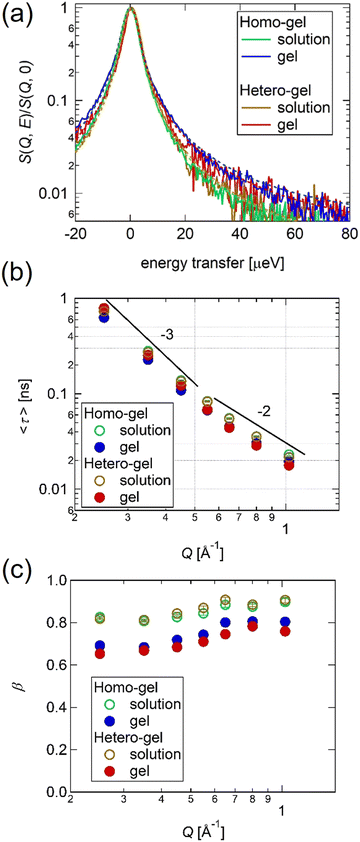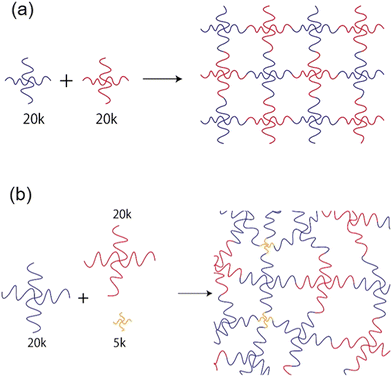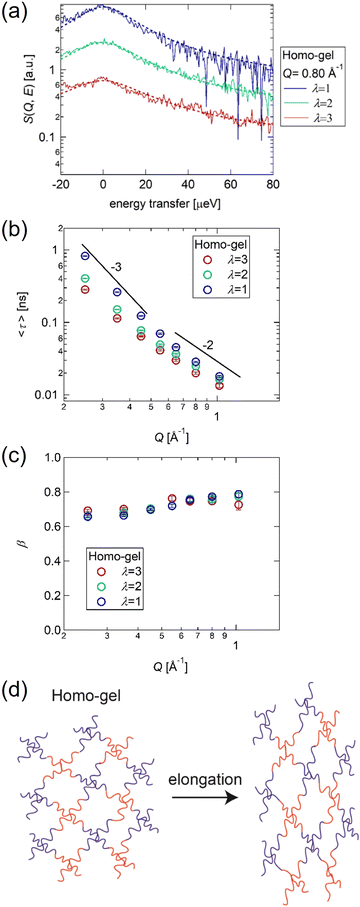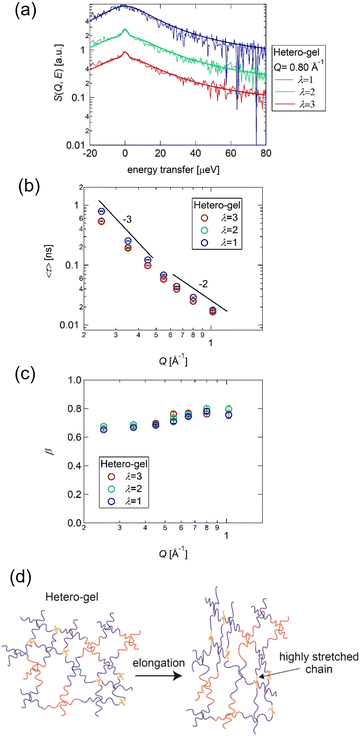Quasi-elastic neutron scattering study on dynamics of polymer gels with controlled inhomogeneity under uniaxial deformation
Kosuke
Aomura
ab,
Yusuke
Yasuda
a,
Takeshi
Yamada
c,
Takamasa
Sakai
 d and
Koichi
Mayumi
d and
Koichi
Mayumi
 *ab
*ab
aMaterial Innovation Research Center (MIRC) and Department of Advanced Materials Science, Graduate School of Frontier Sciences, The University of Tokyo, 5-1-5 Kashiwanoha, Kashiwa, Chiba 277-8561, Japan. E-mail: kmayumi@g.ecc.u-tokyo.ac.jp
bThe Institute for Solid State Physics, The University of Tokyo, 5-1-5 Kashiwanoha, Kashiwa-Shi, Chiba 277–8581, Japan
cNeutron Science and Technology Center, Comprehensive Research Organization for Science and Society (CROSS), IQBRC Bldg., 162-1 Shirakata, Tokai, Naka, Ibaraki 319-1106, Japan
dDepartment of Bioengineering, Graduate School of Engineering, The University of Tokyo, 7-3-1 Hongo, Bunkyo-ku, Tokyo, Japan
First published on 25th November 2022
Abstract
We study the segmental and monomer dynamics of polymer gels with controlled inhomogeneity under uniaxial deformation by means of quasi-elastic neutron scattering (QENS). In order to clarify the effect of the homogeneity of a network structure on the polymer dynamics in gels, we compare two types of polymer gels with controlled homogeneity: a homogeneous tetra-PEG gel (homo-gel) prepared from uniform tetra-arm pre-polymers and a heterogeneous tetra-PEG gel (hetero-gel) with a small amount of shorter tetra-PEG pre-polymer. The different inhomogeneity in the homo-gel and the hetero-gel has little effect on the average relaxation time of the chain dynamics in the undeformed state. The difference in the local dynamics in the gels is emphasized under uniaxial deformation: while the homo-gel shows a single relaxation mode, the hetero-gel exhibits a bimodal distribution of relaxation times with a slow dynamic mode ascribed to highly stretched short strands, which causes a more brittle macroscopic fracture compared with that in the case of the homo-gel.
1. Introduction
Hydrogels, cross-linked polymer networks containing water, are expected to be applied for biomaterials such as artificial cartilage, vessels, and prosthetic joints due to their high water content and biocompatibility.1 For the applications as biomaterials, the mechanical toughness of polymer gels is not enough and needs to be improved. The reason for the brittleness of polymer gels is the heterogeneous strain distribution caused by their inhomogeneous network structure.2,3 When a polymer gel is stretched, local stress concentrates on short strands between cross-links. The stress-concentrated strands are highly stretched and become potential fracture onsets, which dominate the macroscopic fracture properties of polymer gels. The stress concentration under deformation can be visualized by the introduction of mechanically responsive chemical groups, mechanophores, into polymer networks.4–6 The mechanophores emit light in response to applied force, and serve as molecular sensors to detect the stress concentration in deformed polymeric materials. However, the complexity of the synthesis procedures for the mechanophores and their miscibility with polymer matrices limit their broad application to polymeric materials.Here, we focus on the molecular dynamics of polymer chains to detect the strain distribution in polymer networks without adding any probes. Polymer chains exhibit hierarchical dynamics on various time and spatial scales: cooperative diffusion of polymer networks, the Rouse/Zimm mode corresponding to the dynamics of connected segments, and the monomer diffusion mode.7–21 The segment and monomer dynamics in cross-linked polymer gels in an un-deformed state have been studied by quasi-elastic neutron scattering (QENS) techniques.9–21 However, to the best of our knowledge, the segment/monomer dynamics in deformed polymer gels have not been observed yet.
In this study, the segment/monomer dynamics of polymer gels under uniaxial deformation is investigated by means of QENS. In order to clarify the effect of heterogeneity in a polymer network structure, we prepared two types of polymer gels with controlled heterogeneities: a homogeneous tetra-PEG gel prepared by end-cross-linking of tetra-arm prepolymers (homo-gel),22 and a heterogeneous tetra-PEG gel (hetero-gel) containing a small amount of tetra-PEG prepolymers with shorter arms.23 The hetero-gel shows a more brittle fracture behavior than the homo-gel, which suggests that a stress-concentration occurs in hetero-gel under deformation. From the QENS results, we demonstrate how the homogeneity of the network structure affects the segment/monomer dynamics of polymer gels in the un-deformed and stretched states. The hetero-gel exhibits an elastic component in its dynamic scattering factor, which corresponds to the slow dynamics of highly stretched strands and is the molecular origin of the brittleness of the polymer gel.
2. Experimental section
2.1 Sample preparation
We prepared the tetra-PEG gel by end-crosslinking of N-hydroxysuccinimide (NHS)-terminated tetra-PEG and amino-terminated tetra-PEG. The homogeneous tetra-PEG gel, homo-gel (Fig. 1(a)), was fabricated by using NHS-terminated and amino-terminated tetra-PEGs with the same total molecular weight, 20k (SUNBRIGHT PTE-200HS and PTE-200PA, NOF Corporation (Tokyo, Japan)). The heterogeneous tetra-PEG gel, hetero-gel (Fig. 1(b)), was prepared from PTE-200HS, PTE-200PA, and amino-terminated tetra-PEG with a smaller total molecular weight, 5k (SUNBRIGHT PTE-50PA, NOF Corporation (Tokyo, Japan)).23 The strand length in the hetero-gel is not uniform, but bimodal.For the homo-gel, the two tetra-PEGs, PTE-200PA and PTE-200HS, were dissolved separately in 0.1 M phosphate buffer (pH = 7.0) with a polymer concentration of 10 wt%. The phosphate buffer was prepared by mixing disodium phosphate, phosphoric anhydride, and sodium hydrogen anhydrate in D2O. The two solutions of PTE-200PA and PTE-200HS were mixed and injected into a mold, and were left to stand for a day to proceed with the gelation reaction. Finally, we obtained a sheet of the hetero-gel with 1 mm thickness. The hetero-gel was prepared from PTE-200HS and PTE-200PA/PTE-50PA solutions. The concentration of PTE-200HS was 10 wt%, while the concentrations of PTE-200PA and PTE-50PA were 8.5 wt% and 2.5 wt% in the PTE-200PA/PTE-50PA solution, respectively. The gelation process of hetero-gel was the same as that of homo-gel. The final concentration of PTE-50PA in hetero-gel was 1.25 wt%.
Also, as a reference, we prepared tetra-PEG solutions with the same compositions as those of the tetra-PEG gels (homo-gel and hetero-gel). For a comparison with the homo-gel and hetero-gel, we prepared 10 wt% PTE-200HS solution and PTE-200PA/PTE-50PA solution, respectively. The solvent of both the solutions was 0.1 M deuterated phosphate buffer. In the PTE-200PA/PTE-50PA solution, the concentrations of PTE-200PA and PTE-50PA were 8.75 wt% and 1.25 wt%, respectively.
2.2 Uniaxial tensile test
Uniaxial tensile tests on homo-gel and hetero-gel were performed on a mechanical testing apparatus (EZ-S-500N, SHIMADZU, Kyoto, Japan). For the tensile tests, we used stripe-shaped gel specimens with 1 mm thickness and 3 mm width. The initial gap between cramps was 20 mm. The cross-head speed was set as 50 mm min−1.2.3 Quasi-elastic neutron scattering
For QENS measurements of un-deformed homo-gel and hetero-gel, we prepared gel sheets (40 mm × 42 mm × 1 mm) and covered them with aluminum foils. The gel sheets were put into aluminum cylinder cells having 14 mm inner diameter and 0.25 mm thickness. For the QENS experiments of the stretched tetra-PEG gels (homo-gel and hetero-gel), the gel sheets were cut into smaller specimens (10 mm × 20 mm × 1 mm for extension ratio λ = 2 and 10 mm × 13 mm × 1 mm for λ = 3). Each specimen was stretched with hands to a length of 40 mm, and the strain was maintained by fixing the edges of the specimen on an aluminum foil via an epoxy adhesive. For each extension ratio, 4 specimens were attached on the aluminum foil. The stretched gel specimens were set in a 2 mm gap of concentric double cylinder aluminum cells having 14 mm inner diameter of the outer cylinder and 10 mm outer diameter of the inner cylinder. In order to avoid the scattering from the adhesives, the top and bottom parts of the cells were covered with cadmium sheets. The tetra-PEG solutions were set into a 1 mm gap of concentric double cylinder aluminum cells having 14 mm inner diameter of the outer cylinder and 12 mm outer diameter of the inner cylinder. All the aluminum cells were sealed with indium wire.The QENS measurements were conducted using a time-of-flight near-backscattering spectrometer DNA BL02, at the Materials and Life Science Experimental Facility (MLF) at the Japan Proton Accelerator Research Complex (J-PARC) in Ibaraki, Japan.24,25 The energy resolution was 2.8 and 3.6 μeV for gels and solutions, respectively, and the energy transfer ranged from −0.02 to 0.1 meV. The incident neutron beam and scattering vector were perpendicular to the stretching direction of the gels as shown in Fig. 2. The covered angle of the Si(111) plane analyzed was from −14 to 21° and from −30 to 138° in vertical and horizontal directions, respectively. The amplitude of the scattering vector, Q, was in the range of 0.125 to 1.825 Å−1. Each measurement was carried out at 300 K for 6 hours with 500 kW proton beam power. The data were circular averaged in the data reduction. To extract the dynamics of the solute, the scattering from the solvent was removed by subtraction based on the volume fraction.
 | ||
| Fig. 2 (a) Schematic illustration of stretching gels. (b) Schematic illustration of the experimental setup for QENS measurements of stretched gels. | ||
3. Results and discussion
3.1 Tensile tests
Fig. 3 shows the stress–extension ratio (σ − λ) curves of homo-gel and hetero-gel. Young's moduli of homo-gel and hetero-gel are 49 kPa and 50 kPa, respectively, which suggests that the average network densities in these two gels are almost the same.23 However, the hetero-gel fractures at an extension ratio λ = 4.5, while the homo-gel can be stretched up to λ = 7. Since the hetero-gel contained short tetra-PEG, the network structure was heterogeneous compared with that of the homo-gel. This heterogeneity of the network structure causes stress concentration on the short strands under stretching and a lower strain at break for the hetero-gel. This result is consistent with that of the previous work on bimodal tetra-PEG gels.233.2 Effects of gelation on polymer dynamics
The effect of gelation on polymer chain dynamics was studied by comparing QENS results of the tetra-PEG solutions and gels. Fig. 4(a) shows dynamic structure factors S(Q, ω) of the tetra-PEG precursor solutions and gels at Q = 0.35 Å−1. Both homo- and hetero-gels show no elastic component attributed to slow dynamics compared to energy resolution. The dynamic structure factors were fitted using the KWW function: | (1) |
 | (2) |
 | ||
| Fig. 4 (a) Dynamic structure factors S(Q,ω) at Q = 0.35 Å−1, (b) Q dependence of average relaxation time τ and (c) Q dependence of stretching exponent β for the tetra-PEG gels and solutions. | ||
3.3 Effects of stretching on polymer dynamics in gels
Next, Fig. 5(a) shows S(Q, ω) for the homo-gel under uniaxial deformation (λ = 1, 2, and 3) at Q = 0.8 Å−1. The dynamic structure factors were fitted with eqn (1) and the fitting results are shown as dashed lines. As shown in Fig. 5(b), the average relaxation times τ of homo-gel decrease with increasing stretching, and the segment/monomer dynamics in the gel are accelerated by stretching. Interestingly, β for the homogeneous gel is not changed with stretching (Fig. 5(c)), suggesting that the local deformation in the gel is kept homogeneous (Fig. 5(d)).Fig. 6(a) shows S(Q, ω) for the hetero-gel under uniaxial deformation (λ = 1, 2, and 3) at Q = 0.8 Å−1. A sharp elastic peak corresponding to slow chain dynamics with a broad base was observed under deformation (λ = 2 and 3), while only a broad peak was seen in the un-deformed state (λ =1). This means that the slow chain dynamics appears only for the deformed hetero-gel. Therefore, in these cases, S(Q, ω) factors were fitted using the following equation with the sum of the KWW function for the relaxation component and delta function for the elastic component:
 | (3) |
The elastic component can be ascribed to a slow chain dynamics of highly stretched short strands. When the hetero-gel is stretched, the short strands oriented in the stretching direction are strongly stretched and the chain dynamics of the highly deformed chains is suppressed. Fig. 6(b) and (c) shows the Q dependence of the average relaxation time τ and stretching exponent β for the quasi-elastic component fitted with the KWW function, respectively. The relaxation component corresponds to the dynamics of the rest of the polymer strands except for the highly stretched chains. As shown in Fig. 6(b), although the average relaxation time becomes shorter with stretching, the extension ratio dependence of the average relaxation time for the hetero-gel is weaker than that for the homo-gel (Fig. 5(b)). The weak dependence of the relaxation time suggests that the stress/strain concentration on some short strands in the hetero-gel relaxes the local deformation of the other polymer strands mainly composed of long chains (Fig. 6(d)). As shown in Fig. 6(c), β of the QENS component is almost independent of λ, which means that the relatively relaxed strands are deformed uniformly with stretching. The average fraction of the elastic component, A1/(A1 + A2) is 1.4% for λ = 2 and 3 within the measured Q range, which is less than the fraction of proton number of the short pre-polymer PTE-50PA, 12.5%. This result suggests that the stress concentration occurs on about 11% monomers of the short strands in hetero-gel.
4. Conclusion
In this work, we investigated the segmental and monomer dynamics in homogeneous and heterogeneous tetra-PEG gels (homo-gel and hetero-gel) by QENS. Compared with the tetra-PEG solutions, the un-deformed tetra-PEG gels show about the same segmental and monomer dynamics. While the heterogeneity of the polymer networks does not influence the local chain dynamics in the un-deformed state, the inhomogeneity of the network structure is crucial for the local chain dynamics under stretching. The hetero-gel under stretching exhibits a small elastic peak corresponding to the slow dynamics of highly stretched short strands, while for the homo-gel, only a broad quasi-elastic component was observed. The existence of the highly stretched strands results in the smaller strain/stress at break for the heterogeneous gels. QENS measurements on deformed polymer gels and elastomers are quite useful to detect stress concentrations in the materials and deepen the understanding of the fracture mechanism.Conflicts of interest
There are no conflicts to declare.Acknowledgements
The authors would like to thank Prof. Kohzo Ito, Prof. Hideaki Yokoyama, and Dr Xiang Li for their helpful comments. This work was supported by the ImPACT Program of the Council for Science, Technology and Innovation (Cabinet Office, Government of Japan), JST-Mirai program grant number JPMJMI18A2, JST CREST grant number JPMJCR1992, JST SPRING grant number JPMJSP2108 and the Materials Education Program for the future leaders in the Research, Industry, and, JSPS KAKENHI grant number JP20K05627. The neutron experiment at the Materials and Life Science Experimental Facility of the J-PARC was performed under a user program (proposal no. 2018B0232 and 2019A0304).References
- K. Y. Lee and D. J. Mooney, Hydrogels for Tissue Engineering, Chem. Rev., 2001, 101, 1869–1880 CrossRef CAS PubMed.
- M. Shibayama, Small-Angle Neutron Scattering on Polymer Gels: Phase Behavior, Inhomogeneities and Deformation Mechanisms, Polym. J., 2011, 43, 18–34 CrossRef CAS.
- K. Ito, Novel Cross-Linking Concept of Polymer Network: Synthesis, Structure, and Properties of Slide-Ring Gels with Freely Movable Junctions, Polym. J., 2007, 39, 489–499 CrossRef CAS.
- D. A. Davis, A. Hamilton, J. Yang, L. D. Cremar, D. Van Gough, S. L. Potisek, M. T. Ong, P. V. Braun, T. J. Martínez, S. R. White, J. S. Moore and N. R. Sottos, Force-Induced Activation of Covalent Bonds in Mechanoresponsive Polymeric Materials, Nature, 2009, 459, 68–72 CrossRef CAS PubMed.
- M. M. Caruso, D. A. Davis, Q. Shen, S. A. Odom, N. R. Sottos, S. R. White and J. S. Moore, Mechanically-Induced Chemical Changes in Polymeric Materials, Chem. Rev., 2009, 109, 5755–5798 CrossRef CAS.
- C. L. Brown and S. L. Craig, Molecular Engineering of Mechanophore Activity for Stress-Responsive Polymeric Materials, Chem. Sci., 2015, 6, 2158–2165 RSC.
- M. Doi and S. F. Edwards, The Theory of Polymer Dynamics, Oxford University Press, Oxford, 1988 Search PubMed.
- T. Tanaka, L. O. Hocker and G. B. Benedek, Spectrum of light scattered from a viscoelastic gel, J. Chem. Phys., 1973, 59, 5151–5159 CrossRef CAS.
- B. Ewen and D. Richter, Neutron Spin Echo Investigations on the Segmental Dynamics of Polymers in Melts, Networks and Solutions, Adv. Polym. Sci., 1997, 134, 1–129 CrossRef CAS.
- D. Richter, M. Monkenbusch, A. Arbe and J. Colmenero, Neutron Spin Echo in Polymer Systems, Adv. Polym. Sci., 2005, 174, 1–221 Search PubMed.
- A. M. Hecht, A. Guillermo, F. Horkay, S. Mallam, J. F. Legrand and E. Geissler, Structure and Dynamics of a Poly(dimethylsiloxane) Network: A Comparative Investigation of Gel and Solution, Macromolecules, 1992, 25, 3677–3684 CrossRef CAS.
- A. M. Hecht, F. Horkay, P. Schleger and E. Geissler, Thermal fluctuations in polymer gels investigated by neutron spin echo and dynamic light scattering, Macromolecules, 2002, 35, 8552–8555 CrossRef CAS.
- S. Koizumi, M. Monkenbusch, D. Richter, D. Schwahn and B. Farago, Concentration Fluctuations in Polymer Gel Investigated by Neutron Scattering: Static Inhomogeneity in Swollen Gel, J. Chem. Phys., 2004, 121, 12721–12731 CrossRef CAS.
- S. Koizumi, M. Monkenbusch, D. Richter, D. Schwahn, B. Farago and M. Annaka, Frozen concentration fluctuations in a poly(N-isopropyl acrylamide) gel studied by neutron spin echo and small-angle neutron scattering, Appl. Phys. A: Mater. Sci. Process., 2002, 74, S399–S401 CrossRef CAS.
- T. Kanaya, N. Takahashi, K. Nishida, H. Seto, M. Nagao and T. Takeda, Neutron Spin-Echo Studies on Dynamic and Static Fluctuations in Two Types of Poly (vinyl alcohol) Gels, Phys. Rev. E: Stat., Nonlinear, Soft Matter Phys., 2005, 71, 011801 CrossRef CAS.
- T. Kanaya, N. Takahashi, K. Nishida, H. Seto, M. Nagao and Y. Takeba, Dynamic and static fluctuations in polymer gels studied by neutron spin-echo, Phys. B, 2006, 385–386, 676–681 CrossRef CAS.
- N. Onoda-Yamamuro, O. Yamamuro, Y. Inamura and H. Nomura, QENS study on thermal gelation in aqueous solution of methylcellulose, Phys. B, 2007, 393, 158–160 CrossRef CAS.
- K. Mayumi and K. Ito, Structure and dynamics of polyrotaxane and slide-ring materials, Polymer, 2010, 51, 959–967 CrossRef CAS.
- T. Hiroi, M. Ohl, T. Sakai and M. Shibayama, Multiscale Dynamics of Inhomogeneity-Free Polymer Gels, Macromolecules, 2014, 47, 763–770 CrossRef CAS.
- K. Gawlitza, O. Ivanova, A. Radulescu, O. Holderer, R. von Klitzing and S. Wellert, Bulk Phase and Surface Dynamics of PEG Microgel Particles, Macromolecules, 2015, 48, 5807–5815 CrossRef CAS.
- E. Dubois-Violette and P.-G. de Gennes, Quasi-Elastic Scattering by Dilute, Ideal, Polymer Solutions: II. Effects of Hydrodynamic Interactions, Phys. Phys. Fiz., 1967, 3, 181–198 Search PubMed.
- T. Sakai, T. Matsunaga, Y. Yamamoto, C. Ito, R. Yoshida, S. Suzuki, N. Sasaki, M. Shibayama and U. I. Chung, Design and Fabrication of a High-Strength Hydrogel with Ideally Homogeneous Network Structure from Tetrahedron-like Macromonomers, Macromolecules, 2008, 41, 5379–5384 CrossRef CAS.
- S. Kondo, H. Sakurai, U. I. Chung and T. Sakai, Mechanical Properties of Polymer Gels with Bimodal Distribution in Strand Length, Macromolecules, 2013, 46, 7027–7033 CrossRef CAS.
- K. Shibata, N. Takahashi, Y. Kawakita, M. Matsuura, T. Yamada, T. Tominaga, W. Kambara, M. Kobayashi, Y. Inamura, T. Nakatani, K. Nakajima and M. Arai, The Performance of TOF Near Backscattering Spectrometer DNA in MLF, J-PARC, Proceedings of the 2nd International Symposium on Science at J-PARC—Unlocking the Mysteries of Life, Matter and the Universe—2015, p. 036022.
- H. Seto, S. Itoh, T. Yokoo, H. Endo, K. Nakajima, K. Shibata, R. Kajimoto, S. Ohira-Kawamura, M. Nakamura, Y. Kawakita, H. Nakagawa and T. Yamada, Inelastic and Quasi-Elastic Neutron Scattering Spectrometers in J-PARC, Biochim. Biophys. Acta, Gen. Subj., 2017, 1861, 3651–3660 CrossRef CAS.
- T. Matsunaga, T. Sakai, Y. Akagi, U. I. Chung and M. Shibayama, Structure Characterization of Tetra-PEG Gel by Small-Angle Neutron Scattering, Macromolecules, 2009, 42, 1344–1351 CrossRef CAS.
- T. Matsunaga, T. Sakai, Y. Akagi, U. I. Chung and M. Shibayama, SANS and SLS Studies on Tetra-Arm PEG Gels in As-Prepared and Swollen States, Macromolecules, 2009, 42, 6245–6252 CrossRef CAS.
| This journal is © The Royal Society of Chemistry 2023 |




